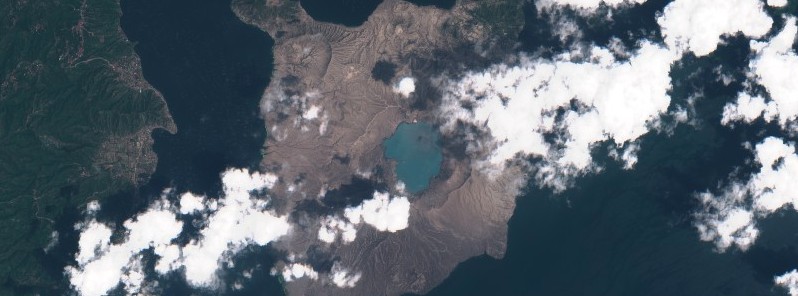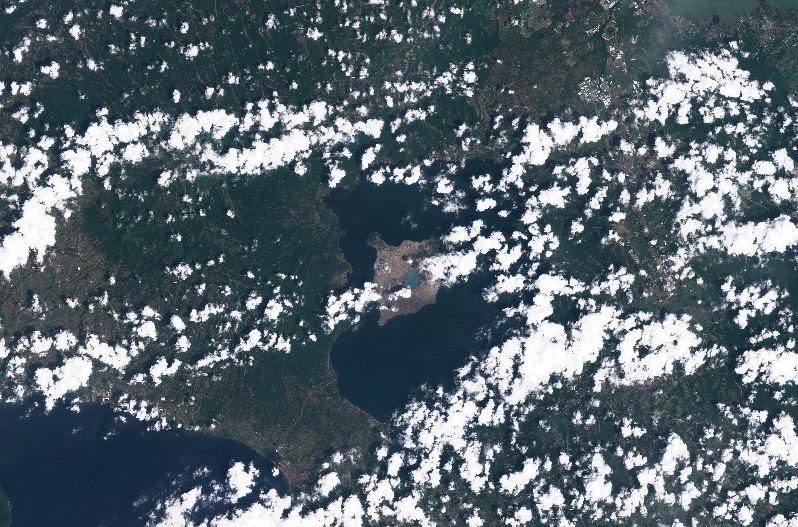Increased possibility of magmatic eruption at Taal volcano, Philippines

There is an increasing possibility of magmatic eruption at Taal volcano, PHIVOLCS warned on March 24, 2021.
A total of 2 015 volcanic tremors, 734 low-frequency volcanic earthquakes, and 18 hybrid earthquake events have been recorded by the Taal Volcano Network since ongoing unrest began at the volcano on February 13, 2021.
Since March 19, harmonic tremor associated with magma migration has become the dominant type of earthquake.
Most earthquake events occurred at shallow depths of less than 2 km (1.2 miles) although some large earthquakes were generated in the deeper, 2 – 6 km (1.2 – 3.7 miles) region beneath the Taal Volcano Island (TVI) edifice.
Overall seismic energy release has markedly increased since yesterday afternoon compared to previous seismic swarms.
Sulfur dioxide gas emission in the previous week has been generally high with a peak of 1 184 tonnes per day on March 21, 2021. Ground deformation of TVI and the Taal Caldera region, in general, has remained steady and at slight inflationary trends since February 2021.
The above parameters indicate that magma has been migrating across shallow depths beneath TVI, increasing the possibilities of magmatic eruption.

Taal volcano on March 18, 2021. Credit: Copernicus EU/Sentinel-2, TW
Alert Level 2 (Increased Unrest) is currently maintained over Taal Volcano but that unrest has been elevating and is under constant evaluation.
DOST-PHIVOLCS reminds the public that at Alert Level 2, sudden steam-driven or phreatic explosions, volcanic earthquakes, minor ashfall, and lethal accumulations or expulsions of volcanic gas can occur and threaten areas within and around TVI
Entry into Taal Volcano Island, Taal’s Permanent Danger Zone or PDZ, especially the vicinities of the Main Crater and the Daang Kastila fissure, and occupancy and boating on Taal Lake, must be strictly prohibited.
Local government units are advised to continuously assess and strengthen the preparedness of previously evacuated barangays around Taal Lake in case of renewed unrest.
Disaster response officials have ordered the evacuation of residents living near the volcano on February 16, 2021.
Taal erupted in January 2020 for the first time in decades, ejecting volcanic ash up to 16.7 km (55 000 feet) above sea level and affecting the lives of at least 500 000 people.
Geological summary
Taal is one of the most active volcanoes in the Philippines and has produced some of its most powerful historical eruptions. Though not topographically prominent, its prehistorical eruptions have greatly changed the topography of SW Luzon.
The 15 x 20 km (9 x 12 feet) Talisay (Taal) caldera is largely filled by Lake Taal, whose 267 km2 (103 mi2) surface lies only 3 m (9.8 feet) above sea level.
The maximum depth of the lake is 160 m (525 feet), and several eruptive centers lie submerged beneath the lake. The 5 km (3.1 miles) wide Volcano Island in north-central Lake Taal is the location of all historical eruptions.
The island is composed of coalescing small stratovolcanoes, tuff rings, and scoria cones that have grown about 25% in the area during historical time. Powerful pyroclastic flows and surges from historical eruptions have caused many fatalities. (GVP)
Featured image: Taal volcano on March 18, 2021. Credit: Copernicus EU/Sentinel-2, TW

Commenting rules and guidelines
We value the thoughts and opinions of our readers and welcome healthy discussions on our website. In order to maintain a respectful and positive community, we ask that all commenters follow these rules:
We reserve the right to remove any comments that violate these rules. By commenting on our website, you agree to abide by these guidelines. Thank you for helping to create a positive and welcoming environment for all.